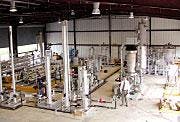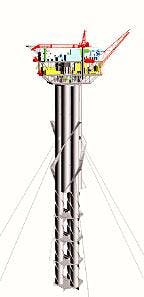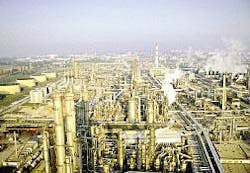Market Movement
Iraqi war poses less threat to E&P stocks this time
If the US takes military action against Iraq, oil prices probably will tumble as other members of the Organization of Petroleum Exporting Countries again increase production to offset the loss of Iraqi exports, as they did in 1991, said Robert Morris at Salomon Smith Barney Inc.
But stock values of exploration and production companies are less likely to follow oil prices down this time, he said. Such a fall "will be partly mitigated, particularly for natural gas-weighted companies, by the expected strength of natural gas prices in 2003."
Concerns over Middle East hostilities-of which anticipation of an imminent US-Iraqi conflict is the latest manifestation-have lifted oil prices more than 60% from a low of $18/bbl in mid-January.
"During this same time period, E&P shares have gained nearly 20%, concurrent with a roughly 30% increase in natural gas prices while the S&P 500 has declined about 15%," Morris said (see chart). "The question on most people's minds is how E&P shares might react should the US ultimately invade Iraq."
Reactions
Investors' response "is highly dependent on the actual timing, duration, and outcome of the operation," said Morris. "If the US attacks Iraq before yearend, E&P stocks are more likely to decline if oil prices drop sharply than if the attack occurs next year." That's because of "the increasing tightness in the North American natural gas supply-demand balance, particularly heading into this winter and through 2003," he said. Gas market fundamentals are much tighter than in 1990-91. "Consequently, E&P stocks have recently traded more in response to natural gas than crude oil prices," Morris explained. "We believe the impact of a potential conflict with Iraq on our 2003 natural gas price outlook would be minimal, primarily because the supply-demand balance will continue to tighten regardless of oil prices."
He sees an average composite spot gas price of $3.50/MMbtu for 2003, with benchmark US crude averaging $20/bbl and gas losing 4 bcfd of its market to cheaper competitive fuel. "However, if the situation between the US and Iraq is not resolved or the military engagement becomes extended, and oil prices retain their current 'war premium,'...then we would not expect any significant natural gas demand to be lost," Morris said. "Under this scenario, our $3.50/MMbtu composite spot natural gas forecast, assuming normal winter conditions, could prove conservative."
1990-91 crisis
Escalating tensions increased oil prices roughly 20% to more than $21/bbl in the 3 months leading up to Iraq's invasion of Kuwait in 1990. But E&P shares posted a modest 4% gain in that period, Morris said. Following the invasion, oil prices surged 85% to nearly $40/bbl in early October as 5 million b/d of Iraqi and Kuwaiti production-nearly 8% of the world's oil supply-was taken off the market. E&P shares on average gained 9% during that time, "although they peaked 2 weeks earlier than oil prices," said Morris.
However, he said, "Oil prices declined nearly 30% from their peak in early October to the start of operation Desert Storm on Jan. 17, 1991. Interestingly, E&P shares also declined roughly 30% from their peak in late September to the start of Desert Storm, ending up roughly 20% below their preconflict levels." During the Jan. 17-Feb.27, 1991, combat, oil prices fell another 30% while E&P shares gained about 9%, "concurrent with an 18% rise in the broader markets. Thus, E&P shares wound up about 14% below their preconflict levels at the end of the (Persian) Gulf War vs. a 4% gain by the S&P 500," Morris said.
Industry Scoreboard
null
null
null
Industry Trends
A new, patented gas-to-liquids technology for converting stranded and associated natural gas into hydrocarbon liquids has been announced by Texas A&M University's Texas Engineering Experiment Station (TEES), the state's engineering research agency at College Station, Tex.
Sponsors of the research tout its applicability in smaller-scale plants than is typically seen with current GTL technology.
The new GTL process, developed by researchers at Texas A&M University, produces a light naphtha and could be economical for gas production as small as 1 MMcfd, according to sponsors (OGJ, Mar. 12, 2001, p. 58).
Texas A&M licensed the technology to Conquest Resources Corp., which then formed Synfuels International Inc. (SFI), Dallas.
SFI built a GTL pilot plant near the Texas A&M campus where the research was conducted. S&B Engineers & Constructors Ltd., Houston, is currently conducting an economic analysis and simulation, which is expected to be completed in mid-October.
The new process is much simpler than existing technologies, SFI claims, does not require syngas, and does not use oxygen except in power generation. It differs from the conventional Fischer-Tropsch GTL process, in use since 1923, in economies of scale and production. Using the new process SFI "has the ability to construct plants that vary in size from fully portable to permanent installations. They are physically fractional in size compared with existing technology," the company said.
"This new process will allow oil companies to utilize the natural gas from remote fields," said Kenneth Hall, the TEES chemical engineer who headed up development of the new process. Hall said that using the new technology will enable petroleum companies to access many more stranded resources than is available with current technology.
"With this technology, we can build a facility as small as processing down to 3 MMscfd and volumes up to as large as a Fischer-Tropsch facility," Hall said, adding that the first commercial unit could be available in early 2004.
The process also opens the possibility of recovering-as hydrocarbon liquids-gas from remote locations such as Alaska's North Slope.
Currently, more than 15 tcf/year of stranded natural gas is burned, vented, or reinjected because companies have no way to recover and transport the remote gas to market, TEES said. In addition, environmental regulations in many areas prevent flaring of gas, compounding the challenge of producing oil.
SFI Pres. Ben R. Weber Jr. said that petroleum companies can construct the plants almost anywhere because of their small size and portability, even on or near remote drilling sites. As a result, oil and natural gas can be produced in areas previously considered impractical or uneconomic.
"GTL is necessary technology, considering (that) over half of the world's gas reserves are stranded," the company said.
Government Developments
WITH CONGRESS EXPECTED back from a month-long recess in early September, industry groups are gearing up for a final lobbying push on energy reform legislation. Representing a wide cross-section of industry interests, including producers, the National Association of Manufacturers said it supports Conference Chairman Billy Tauzin's (R-La.) announced schedule for finalizing an energy bill in October, "hoping that all lawmakers act in good faith and avoid the temptation to politicize energy for November elections. A comprehensive energy policy is critical to America's long-term economic growth. Congress must act responsibly or be held accountable if it does not," NAM said.
In an Aug. 26 weekly report, NAM offered several talking points for its members to use when approaching Capitol Hill staff.
"Higher energy demand and prices mean higher costs of living and higher business costs; with our nascent economic recovery struggling to gain momentum, these higher costs threaten to spark inflation and underscore the urgent need for a comprehensive energy policy that promotes reliable supplies at affordable prices," the weekly bulletin said. According to NAM, the House bill works in general terms to increase energy supplies, while the Senate bill relies on mandates that "supposedly" improve efficiency.
NAM said it will push to have in the final legislation "key" elements of the House bill, which it characterized as "virtually identical to President (George W.) Bush's energy proposal providing for increased domestic energy supplies, expansion of energy-delivery infrastructure, improved energy efficiency and conservation technologies, and the safeguarding of our environment."
The group also took issue with the Senate bill for including "mandates such as the renewable portfolio standard and climate change title that includes mandatory carbon dioxide reporting (that) are at odds with the president's proposal and would not improve energy efficiency."
According to NAM, mandatory carbon dioxide reporting "is nothing more than a precursor to a cap-and-trade system that could quickly lead to the type of energy rationing envisioned in the Bush-rejected Kyoto Protocol."
NAM, however, said the electricity provisions in the Senate bill are useful, offering "some promise in its electricity title."
NAM told its members that the House and Senate staff worked throughout August "to reconcile many differences" in their two competing versions of a comprehensive energy bill. Some congressional staff, however, took issue with that description, saying that few issues have been completely settled during the recess that ends Sept. 2.
Immediately before leaving for the summer break, lawmakers in late July agreed to 51 relatively noncontroversial provisions related to energy efficiency, Indian energy, and low-income energy assistance. But the heavy lifting on such hotly debated topics as leasing a portion of the Arctic National Wildlife Refuge, clean fuel provisions, a proposed Alaska natural gas pipeline, and sweeping oil and gas tax provisions are still to be reconciled, said staff familiar with discussions.
Quick Takes
KERR-MCGEE CORP., which will operate Red Hawk natural gas field, along with 50:50 joint venture partner Ocean Energy Inc., selected Technip Offshore Inc. to construct the world's first cell spar production platform, which will be used in the deepwater field's development. Located in 5,300 ft of water on Garden Banks Block 877 in the Gulf of Mexico, Red Hawk will be Kerr-McGee's deepest-water development to date.
The innovative floating production cell spar, which is the third generation of spar technology, was developed for economic production in smaller deepwater fields. "This new cell spar technology will allow us to capitalize on our deepwater prospects by reducing the reserve threshold needed for an economical platform de- velopment in deep waters," said Luke R. Corbett, Kerr-McGee chairman and CEO.
The cell spar containing the Red Hawk platform will have a diameter of 64 ft and will be 480 ft in length (see illustration). The design includes seven 20 ft diameter tubes with one tube forming a center surrounded by the other six. All will be connected by structural steel. The deck will be 110 ft by 132 ft.
The spar will have an initial production capacity of 120 MMcfd of natural gas, ultimately rising to 300 MMcfd. Construction of the spar is expected to begin in the fourth quarter. First production from Red Hawk, which has estimated proven reserves of more than 250 bcf, is expected in second quarter 2004.
Other field developments in the gulf received a push forward with recent contracts awarded for subsea flowlines and other development facilities.
BP PLC, operator of Aspen field, awarded a $15 million contract to J. Ray McDermott Inc. subsidiary Mentor Subsea Technology Services Inc. to install facilities associated with Aspen development on Green Canyon Block 243, which is 150 miles south of New Orleans.Mentor Subsea will install and commission 36 miles of dual 7-in. insulated flowlines and an 18 mile control umbilical linking the Aspen development to Shell Offshore Inc.'s Bullwinkle platform on Green Canyon Block 65. Water depths range from 3,100 ft at Aspen to 1,350 ft at the Bullwinkle platform.
Pipelaying work began last week, with McDermott's Derrick Barge 16 utilizing its S-Lay method to lay the flowlines and Derrick Barge 50 installing the umbilical line.
Mentor Subsea also will perform the engineering design, fabrication, installation, and commissioning of two pipeline end manifolds, which will provide tie-ins for the Aspen wells.
Nexen Petroleum USA Inc., which earlier this year increased its interest in Aspen to 60% from 20%, is BP's partner on the block (OGJ Online, Feb. 21, 2002). Production is expected to begin in the fourth quarter.
Also showing progress in the gulf, Paris-based Technip-Coflexip's US unit, Technip Offshore Contractors Inc.—formerly Coflexip Stena Offshore Inc.—received two contracts for installation of deepwater field flowlines.
TotalFinaElf SA subsidiary TotalFinaElf E&P USA Inc. and Chevron Pipe Line Co. awarded a contract for the installation of 15.8 miles of dual 10-in. and 8-in. flowlines and an associated reeled steel catenary riser in Matterhorn field. The field is on Mississippi Canyon Block 243 in 2,816 ft of water. The lines will extend from a tension leg platform to a subsea tie-in with existing pipelines. Installation is scheduled for completion in the fourth quarter.
BP America Production Co. awarded a contract for fabrication and installation of a subsea flowline in its King West development. King West is on Mississippi Canyon Block 84 in water 1,655 m deep. The single pipe-in-pipe, passively insulated flowline will consist of 3.5 km of 6-in. pipe within a 10-in. pipe. The pipe stalks, in 5,000 ft lengths, will be fabricated onshore, welded, and spooled onto the pipelay vessel's reel for installation. The flowline will tie back the King West well from a point near the well to an existing subsea tie-in base associated with the producing King subsea flowline system. Construction is slated for April 2003. Both systems will be installed using the company's new CSO Deep Blue ultradeepwater pipelay and construction vessel.
Elsewhere in offshore field development, Statoil ASA is expected to award a contract later this month for construction of the Kristin field platform hull in the Norwegian Sea, while contracts for the flare boom and riser module will likely be let in October, the company said. "It will also be clear in October who will get the contract for preparing and carrying out the installation of the subsea systems and export line," Statoil stated. Meanwhile, Japan's Marubeni-Itochu Steel Inc. received a 100 million kroner contract for manufacture of steel pipe to be used in the field. Marubeni-Itochu, a trading house, represents steel maker Kawasaki Steel Corp. The pipe, which is slated for delivery in fall 2003, will be used for flowlines carrying well streams from subsea installations to a floating platform on the field. Kristin will produce gas and condensate from 12 wells in 4 complexes that will be tied back to the floating platform via 6 flowlines. The system will consist of slightly less than 40 km of pipeline. Kristin field, which will deliver 35 billion cu m of gas until 2016, is expected to come on stream in fall 2005.
BG GROUP PLC reported that Hibiscus field, in the North Coast Marine Area (NCMA) off the north coast of Trinidad, has produced first gas into the newly commissioned Train 2 at Atlantic LNG Co. (ALNG) of Trinidad & Tobago Ltd.'s complex at Point Fortin.
NCMA is 40 km offshore and contains three gas fields-Hibiscus, Poinsettia, and Chaconia-with total proved and probable reserves of 2.4 tcf, BG said. NCMA, which is one of the largest offshore developments in the waters surrounding the dual island nation, is expected to supply 240 MMscfd to Train 2 for a 20-year period.
Partners in NCMA are operator BG 45.9%, state oil company Petroleum Co. of Trinidad & Tobago Ltd. 19.5%, Italy's Agip SPA 17.3%, and Petro-Canada 17.3%.
Three wells are to be drilled in Phase 2 of NCMA's development scheme. They will be brought into production during second quarter 2003. During Phase 3, BG will drill six subsea wells in Poinsettia field, which will begin production in 2009. "A possible fourth phase would involve installation of compression facilities on the Hibiscus platform," BG said.
Meanwhile, BG and equal partner ChevronTexaco Corp. have received approval from Trinidad's Ministry of Energy and Energy Industries to develop Dolphin Deep and Starfish natural gas fields in the East Coast Marine Area for sale to the US.
The fields will supply a long-term contract with El Paso Merchant Energy LP to deliver 80 MMcfd of natural gas, in the form of LNG, to Southern LNG's Elba Island regasification terminal in Georgia during 2005-23.
BG Trinidad & Tobago operates Dolphin, which currently supplies more than 260 MMscfd of natural gas for domestic use. Under the US supply agreement, natural gas from the fields will be processed at ALNG's third train, currently under construction and scheduled to start up in second quarter 2003.
ALNG's $1.1 billion two-train Point Fortin expansion will increase gross LNG production to 9.9 million tonnes/year from 3.3 million tonnes/year when Train 3 comes on stream. Fourth, fifth, and sixth trains are also planned for the facility.
BG is negotiating with the government of Trinidad and Tobago to allow the proposed 5.2 million tonne Train 4 to be operational in late 2005.
AROMATICS (THAILAND) PLC (ATC), the operator of Thailand's first aromatics complex, has decided to embark on a $25 million scheme to further expand its production capacity, by 13.27%, to 1.1 million tonnes/year.
The firm recently completed first-phase debottlenecking, boosting the plant's output by 57.28% to 972,000 tonnes/year from 618,000 tonnes/year previously.
Company executives said completion of the first-stage debottlenecking, carried out by South Korea's Ssanyong Group at a cost of $12 million, reduced its unit production costs by 20%. ATC's benzene production capacity will increase to 467,000 tonnes/year from 333,000 tonnes/year, its paraxylene to 495,000 tonnes/year from 394,000 tonnes/year, and orthoxylene to 78,000 tonnes/year from 44,000 tonnes/year.
ATC, an affiliate of the partially privatized Thai energy concern PTT PLC, is developing designs for a second-stage debottlenecking, which is due on stream in first quarter 2004.
The second-stage debottlenecking should further improve the cost-effectiveness of the plant, which started up in late 1996 in Rayong, about 220 km southeast of Bangkok.
THE FIRST PERMANENT PIPELINE infrastructure in the West of Shetlands area of the North Atlantic margin has been commissioned. Pipeline engineering, testing, and commissioning operations have been successfully completed for the new line, which is related to an enhanced oil recovery project for BP PLC-operated Magnus field in the UK North Sea.
The Magnus EOR project involves construction of a $320 million subsea pipeline system, to transport natural gas from Foinaven, Schiehallion, and Loyal fields in the West of Shetlands area to the Sullom Voe terminal in Scotland, where the gas will be enriched with natural gas liquids. Another pipeline will transport the enriched gas from the terminal to Magnus platform, where it will be injected into Magnus field to improve oil production.
BJ Process & Pipeline Services (BJ PPS), a unit of BJ Services Co., Houston, reported completing the pipeline tests on behalf of Allseas Construction Contractors SA and Stolt Offshore Ltd. Allseas contracted BJ PPS to deliver pipeline flooding, cleaning and gauging, and hydrotesting services, while BJ PPS was contracted by Stolt Offshore for leak testing, dewatering and conditioning, and hydrocarbon commissioning services. BP expects the $500 million Magnus EOR plan to increase the field's reserves by 50 million bbl of oil and therefore extend the field's life to beyond 2015 (OGJ Online, Dec. 19, 2000).
AUSTRIA'S OMV AG awarded a $15 million contract to Fluor Corp., Aliso Viejo, Calif., for engineering, procurement, and construction management services for the upgrade of OMV's clean diesel and gasoline units at its 208,600 b/d refinery at Schwechat, near Vienna.
Under the contract, Fluor will modify two large columns and compressors, optimize a naphtha treater, and build a new reactor and dehexanizer for OMV.
"The contact calls for the revamping of OMV's units to produce clean diesel with lower sulfur content and clean gasoline with lower aromatics content for use in automobiles to comply with new clean fuels regulations," Fluor said.
The project, which is scheduled for completion in March 2004, will be carried out through Fluor's Haarlem, Netherlands, office. This project marks the first time that Fluor has performed construction management services in Austria, the company said.
Meanwhile, in Canada, Irving Oil Ltd., St. John, NB, and TransCanada Energy Ltd., a unit of TransCanada PipeLines Ltd., Calgary, plan to build an $80 million cogeneration plant at Irving Oil's refinery at St. John. The proposed facility, to be fueled by natural gas, will produce steam and power for refinery operations, enhancing the refinery's energy efficiency and operational reliability while supporting New Brunswick's energy policy promoting cogeneration.








